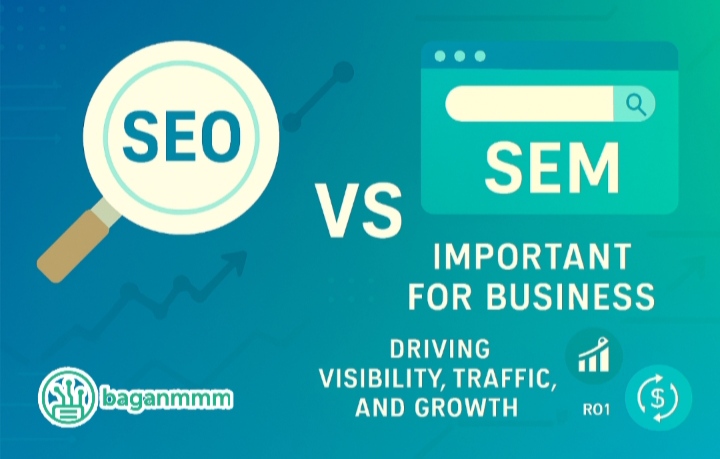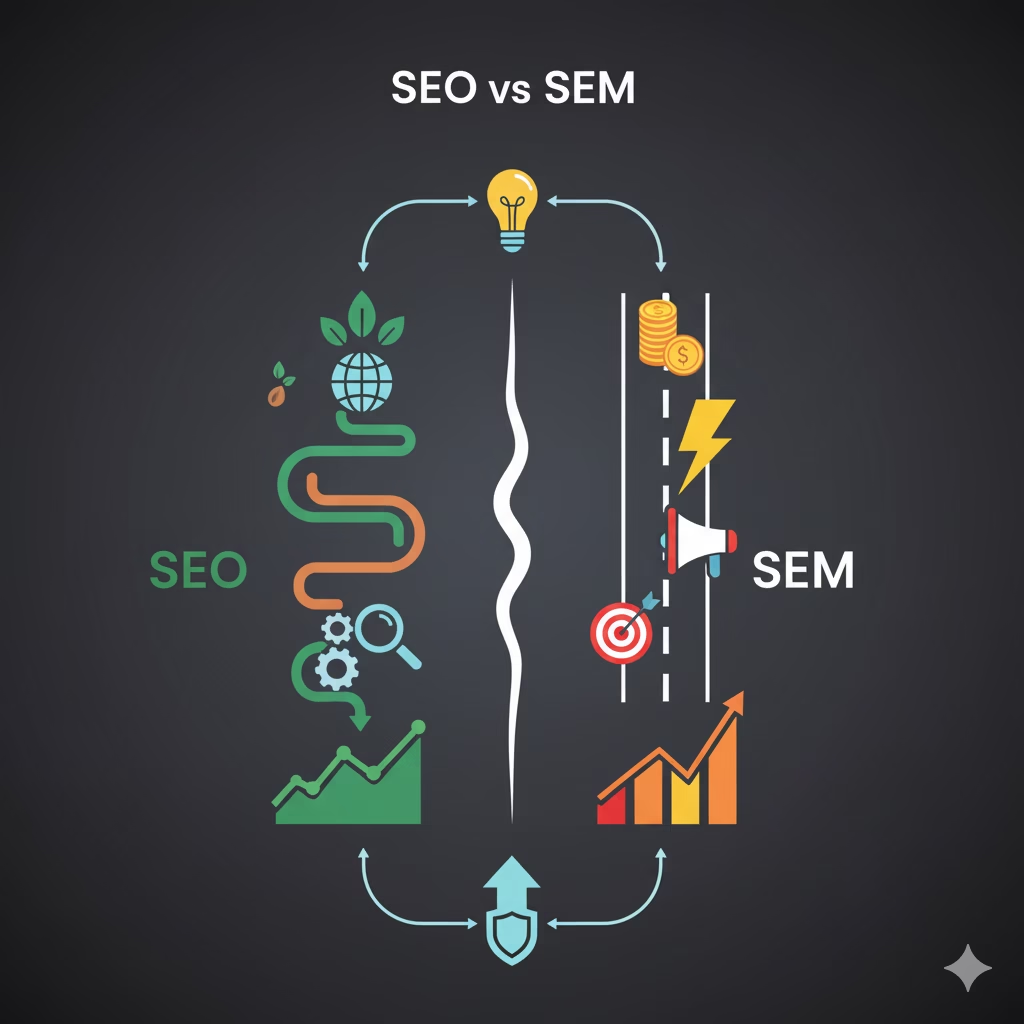Are you struggling to make your website stand out in a world of billions of sites?
If you’re already a digital marketer or working hard to become one. this blog will give you practical insights you can apply right away. Even web developers, especially front‑end specialists, will find these strategies useful.

For any website, SEO (Search Engine Optimization) and SEM (Search Engine Marketing) are not optional they are the foundation of visibility and growth. Without them, even the best‑designed site risks being invisible.
These two pillars are the lifeblood of digital marketing. In this blog, I’ll share the importance of SEO and SEM for businesses, backed by my own experience, and explain how you can use them effectively in 2025.
What You’ll Learn in This Blog
- What SEO Is (and Why It Matters)
- What SEM Is (and Why It Matters)
- SEO vs. SEM: Key Differences
- When to Use SEO vs. SEM
- Why Businesses Should Use Both
- Real‑World Example
- Why SEO and SEM Are Crucial for Business Success in 2025
What Is SEO?
SEO (Search Engine Optimization) is the process of improving your website so it ranks higher in organic (unpaid) search results.
The goal of SEO is to improve a website’s rank by using the most relevant and valuable keywords for your website, and to help it display at the top of search results when users search.
SEO is considered a part of digital marketing and can be applied to any website. It helps improve a website’s visibility on search engines like Google and Microsoft Bing. Whether your site promotes products, offers services, or shares expert knowledge on a specific topic, SEO can increase your website’s traffic.
Key Components of SEO:
- On-Page SEO: Optimizing content, titles, meta descriptions, images, and internal links.
- Off-Page SEO: Building backlinks, social signals, and brand mentions from other websites.
- Technical SEO: Improving site speed, mobile responsiveness, crawlability, and security.
- Content Strategy: Creating valuable, keyword-rich content that answers user intent.
Benefits of SEO
- Increased Website Traffic
SEO makes your website more visible on search engines like Google and Bing, increasing organic traffic. This method is free. - Improved Brand Awareness
Being consistently visible in search results increases people’s awareness of your brand and builds trust. - Credibility & Trust
If you can reach the first page of Google, users will trust your site more. This is a long-term benefit that increases brand credibility. - Cost-Effective Marketing
SEO is beneficial for a longer time than Paid Ads, and it reduces the advertising budget. Since SEO is a free method, it requires patience and time investment. - Better User Experience
When doing SEO, website speed, mobile-friendly design, and content structure are improved, resulting in a better visitor experience. - Long-Term ROI (Return on Investment)
While paid ads are beneficial for only a period of time, SEO can provide traffic for a long time. The ROI (profit) will gradually increase. The longer the time, the more evident the benefits of SEO become. - Local SEO Benefits
Implementing Local SEO allows you to easily reach customers near you, increasing offline sales as well.
These are some of the advantages of SEO. Next, I will explain SEM.
What Is SEM?
Search Engine Marketing (SEM), also called Paid Search, is a paid digital advertising strategy used by advertisers to increase the visibility of your website or product to users. The company that pioneered SEM services was OpenText Corporation. This company created the Pay-Per-Click (PPC) Ads and started providing services to most companies with that system. However, people did not know this method as SEM, and the company did not officially name it. It was technologist and journalist Danny Sullivan who defined and presented this system as the SEM marketing system. That is why the public accepted the term SEM and started using it.
Key Components of SEM:
- Paid Search Ads: Targeted ads that appear above organic results.
- Keyword Bidding: Competing for visibility based on search terms.
- Ad Copy Optimization: Writing compelling headlines and descriptions.
- Landing Page Strategy: Ensuring users convert after clicking your ad.
- Analytics & ROI Tracking: Measuring performance and adjusting campaigns.
Benefits of SEM - Immediate Visibility
Since SEM uses Paid Ads, your website can be visible on the first page of Google immediately. You can get traffic the fastest without having to wait a long time like with SEO. However, there is a cost involved. - Effective Targeting of Specific Audience
You can precisely advertise your Ads based on Keywords, Location, Age Group, and other factors. This is a significant advantage. - Predictable Results
In SEM Campaigns, Clicks, Impressions, and Conversion Rate can be measured accurately. You can accurately predict the ROI (Return on Investment) and adjust the Strategy in real-time. You can adjust and change things immediately as needed. - Improved Brand Awareness
Paid Ads allow many people to see your Brand, increasing trust. If you use a combination of SEO + SEM over time, you can achieve long-term Brand Visibility. - Competitive Advantage
Because you can reach the first page of Google faster than your competitors, you can gain Market Share quickly. This depends on your implementation and financial spending capacity.
These are the advantages of SEM. However, SEM is not free like SEO. But it achieves precise results within a precise timeframe.

SEO vs SEM: Key Differences
| Feature | SEO | SEM |
|---|---|---|
| Traffic Type | Organic (unpaid) | Paid (ads) + organic |
| Cost Structure | Time and effort | Financial investment (PPC) |
| Time to Results | Slow (months) | Fast (days or weeks) |
| Longevity | Long-term | Short-term unless maintained |
| Trust Factor | High (earned ranking) | Lower (sponsored label) |
| Best For | Sustainable growth | Quick wins and targeted campaigns |
When to Use SEO vs SEM
- Use SEO when you want to build long-term traffic, brand authority, and organic visibility.
- Use SEM when you need fast results, want to promote a product, or test new keywords.
- Use both when you want a balanced strategy SEO for stability, SEM for speed.
Many successful businesses combine both strategies to dominate search results from multiple angles.
Real-World Example
Imagine you’re launching a new online course:
- Use SEM to run Google Ads targeting keywords like “learn digital marketing fast” driving immediate traffic and sign-ups.
- Use SEO to publish blog posts like “Top 10 Digital Marketing Skills in 2025” building long-term visibility and trust.
Together, they create a powerful funnel that attracts, converts, and retains users.
Why SEO and SEM Are Crucial for Business Success in 2025
In today’s hyper-digital economy, visibility equals viability. Whether you’re running a blog, launching a product, or scaling a brand, your ability to be found online directly impacts your growth. That’s where SEO (Search Engine Optimization) and SEM (Search Engine Marketing) come in two foundational strategies that help businesses attract, convert, and retain customers through search engines.
What Is SEO and Why It Matters
SEO is the process of optimizing your website to rank higher in organic (unpaid) search results. It helps your business appear when potential customers search for relevant keywords without paying for ads.
Benefits of SEO for Business:
- Long-Term Visibility: Once you rank, you can stay visible with minimal ongoing cost
- Credibility & Trust: Users trust organic results more than paid ads
- Cost-Effective: SEO has lower long-term costs compared to paid campaigns
- High Conversion Potential: SEO leads have a 14.6% close rate far higher than outbound methods
- Local Reach: With tools like Google My Business, SEO helps small businesses dominate local search
SEO is especially powerful for businesses with limited budgets, niche audiences, or long-term growth goals.
What Is SEM and Why It Matters
SEM refers to paid search engine advertising most commonly through platforms like Google Ads. It allows businesses to appear at the top of search results instantly by bidding on keywords.
Benefits of SEM for Business:
- Immediate Results: Ads go live quickly and start driving traffic within hours
- Precise Targeting: You can target users by location, device, behavior, and intent
- Scalable Campaigns: Adjust budgets and strategies based on performance
- Brand Exposure: Even if users don’t click, they see your brand at the top
- Great for Launches: Ideal for promoting new products, events, or seasonal offers
SEM is perfect for businesses that need fast visibility, want to test new markets, or have time-sensitive campaigns.
Why Businesses Should Use Both
SEO and SEM aren’t rivals they’re complementary. Together, they create a balanced search strategy that delivers both short-term wins and long-term growth.
Combined Impact:
- SEM drives instant traffic, while SEO builds lasting authority
- SEM helps test which keywords convert, while SEO helps you rank for them organically
- SEO improves site quality, which boosts SEM performance and lowers ad costs
- SEM fills gaps while SEO is still gaining traction
According to EMB Global, businesses that combine SEO and SEM see stronger engagement, better ROI, and more consistent traffic.
Real-World Business Impact
- E-commerce: SEO helps rank product pages; SEM drives seasonal sales
- Local Services: SEO boosts map visibility; SEM targets nearby customers
- Content Creators: SEO grows YouTube/blog traffic; SEM promotes new videos or courses
- Startups: SEM builds awareness fast; SEO builds trust over time
A study by Marketsplash found that 45% of small businesses prefer SEM for quick results, while SEO remains the foundation for sustainable growth.
Final Thought
I hope this blog has provided you with some valuable insights. Digital marketing is a very broad field.
When we look at digital marketing, it includes areas such as:
– Social Media Marketing
– Email Marketing
– Website Marketing
– SEO and SEM
– Artificial Intelligence Marketing
– and many other branches.
SEO and SEM are just one part of this larger picture. While this blog cannot cover every detail of SEO and SEM strategies, if it has managed to deliver even a small piece of useful value to you, then the effort has been worthwhile.
Alice is the visionary behind Baganmmm Tech, a platform he founded with a passion for demystifying the complex world of technology. As the Lead Technologist, he's often found in his home lab – a cozy, wire-filled sanctuary where ideas are born and code is meticulously crafted. His infectious enthusiasm and knack for explaining intricate concepts make him the go-to expert for everything from web development to emerging tech trends.
